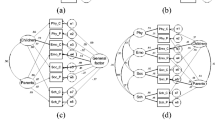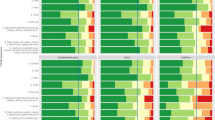Abstract
Measurement equivalence is a necessary assumption for meaningful comparison of pediatric quality of life rated by children and parents. In this study, differential item functioning (DIF) analysis is used to examine whether children and their parents respond consistently to the items in the KINDer Lebensqualitätsfragebogen (KINDL; in German, Children Quality of Life Questionnaire). Two DIF detection methods, graded response model (GRM) and ordinal logistic regression (OLR), were applied for comparability. The KINDL was completed by 1,086 school children and 1,061 of their parents. While the GRM revealed that 12 out of the 24 items were flagged with DIF, the OLR identified 14 out of the 24 items with DIF. Seven items with DIF and five items without DIF were common across the two methods, yielding a total agreement rate of 50 %. This study revealed that parent proxy-reports cannot be used as a substitute for a child’s ratings in the KINDL.
Similar content being viewed by others
References
Dey M, Landolt MA, Mohler-Kuo M (2013) Assessing parent–child agreement in health-related quality of life among three health status groups. Soc Psychiatry Psychiatr Epidemiol 48:503–511
Buck D, Clarke MP, Powell C, Tiffin P, Drewett RF (2012) Use of the PedsQL in childhood intermittent exotropia: estimates of feasibility, internal consistency reliability and parent-child agreement. Qual Life Res 21:727–736
Upton P, Lawford J, Eiser C (2008) Parent-child agreement across child health-related quality of life instruments: a review of the literature. Qual Life Res 17:895–913
Eiser C, Morse R (2001) Can parents rate their child’s health-related quality of life? results of a systematic review. Qual Life Res 10:347–357
Huang IC, Shenkman EA, Leite W, Knapp CA, Thompson LA, Revicki DA (2009) Agreement was not found in adolescents’ quality of life rated by parents and adolescents. J Clin Epidemiol 62:337–346
Scott NW, Fayers PM, Aaronson NK, Bottomley A, de Graeff A, Groenvold M et al (2010) Differential item functioning (DIF) analyses of health-related quality of life instruments using logistic regression. Health Qual Life Outcomes 8:81
Varni JW, Beaujean AA, Limbers CA (2013) Factorial invariance of pediatric patient self-reported fatigue across age and gender: a multigroup confirmatory factor analysis approach utilizing the PedsQL™ Multidimensional Fatigue Scale. Qual Life Res. doi:10.1007/s11136-013-0370-4
Gonzalez A, Weersing VR, Warnick E, Scahill L, Woolston J (2012) Cross-ethnic measurement equivalence of the SCARED in an outpatient sample of African American and non-Hispanic White youths and parents. J Clin Child Adolesc Psychol 41:361–369
Butler AM (2013) Cross-racial measurement equivalence of the eyberg child behavior inventory factors among low-income young African American and non-latino white children. Assessment 20:484–495
Banh MK, Crane PK, Rhew I, Gudmundsen G, Stoep AV, Lyon A et al (2012) Measurement equivalence across racial/ethnic groups of the mood and feelings questionnaire for childhood depression. J Abnorm Child Psychol 40:353–367
Bares C, Andrade F, Delva J, Grogan-Kaylor A, Kamata A (2012) Differential item functioning due to gender between depression and anxiety items among Chilean adolescents. Int J Soc Psychiatry 58:386–392
Wu LT, Ringwalt CL, Yang C, Reeve BB, Pan JJ, Blazer DG (2009) Construct and differential item functioning in the assessment of prescription opioid use disorders among American adolescents. J Am Acad Child Adolesc Psychiatry 48:563–572
Huang IC, Leite WL, Shearer P, Seid M, Revicki DA, Shenkman EA (2011) Differential item functioning in quality of life measure between children with and without special health-care needs. Value Health 14:872–883
Lautamo T, Laakso ML, Aro T, Ahonen T, Törmäkangas K (2011) Validity of the Play Assessment for Group Settings: an evaluation of differential item functioning between children with specific language impairment and typically developing peers. Aust Occup Ther J 58:222–230
Erhart M, Ravens-Sieberer U, Dickinson HO, Colver A, European SPARCLE and KIDSCREEN Groups (2009) Rasch measurement properties of the KIDSCREEN quality of life instrument in children with cerebral palsy and differential item functioning between children with and without cerebral palsy. Value Health 12:782–792
Langer MM, Hill CD, Thissen D, Burwinkle TM, Varni JW, DeWalt DA (2008) Item response theory detected differential item functioning between healthy and ill children in quality-of-life measures. J Clin Epidemiol 61:268–276
Lin CY, Luh WM, Cheng CP, Yang AL, Su CT, Ma HI (2013) Measurement equivalence across child self-reports and parent-proxy reports in the Chinese version of the pediatric quality of life inventory version 4.0. Child Psychiatry Hum Dev 44:583–590
Jafari P, Bagheri Z, Hashemi SZ, Shalileh K (2013) Assessing whether parents and children perceive the meaning of the items in the PedsQL™ 4.0 quality of life instrument consistently: a differential item functioning analysis. Glob J Health Sci 5:80–88
Kim ES, Yoon M (2011) Testing measurement invariance: a comparison of multiple-group categorical CFA and IRT. Struct Equ Model 18:212–228
DeMars C (2010) Item response theory. New York, Oxford
Embretson SE, Reise SP (2000) Item response theory for psychologists. Lawrence Erlbaum Associates, New Jersey
Ostini R, Nering ML (2006) Polytomous item response theory models. Sage Publication, Thousand Oaks
Yang FM, Heslin KC, Mehta KM, Yang CW, Ocepek-Welikson K, Kleinman M (2011) A comparison of item response theory-based methods for examining differential item functioning in object naming test by language of assessment among older Latinos. Psychol Test Assess Model 53:440–460
Ravens-Sieberer U, Bullinger M (1998) Assessing health related quality of life in chronically ill children with the German KINDL: first psychometric and content analytical results. Qual Life Res 7:399–407
Christophersen KA, Helseth S, Lund T (2008) A generalizability study of the Norwegian version of KINDL in a sample of healthy. Qual Life Res 17:87–93
Fernández-López JA, Fernández Fidalgo M, Cieza A, Ravens-Sieberer U (2004) Measuring health-related quality of life in children and adolescents: preliminary validation and reliability of the Spanish version of the KINDL questionnaire. Aten Primaria 33:434–442
Eser E, Yüksel H, Baydur H, Erhart M, Saatli G, Cengiz Ozyurt B et al (2008) The psychometric properties of the new Turkish generic health-related quality of life questionnaire for children (Kid-KINDL). Turk Psikiyatri Derg 19:409–417
Lee PH, Chang LI, Ravens-Sieberer U (2008) Psychometric evaluation of the Taiwanese version of the Kiddo-KINDL generic children’s health-related quality of life instrument. Qual Life Res 17:603–611
Yamaguchi N, Poudel KC, Poudel-Tandukar K, Shakya D, Ravens-Sieberer U, Jimba M (2010) Reliability and validity of a Nepalese version of the Kiddo-KINDL in adolescents. Biosci Trends 4:178–185
Stevanovic D (2009) Serbian KINDL questionnaire for quality of life assessments in healthy children and adolescents: reproducibility and construct validity. Health Qual Life Outcomes 7:79
Bullinger M, Brütt AL, Erhart M, Ravens-Sieberer U, BELLA Study Group (2008) Psychometric properties of the KINDL-R questionnaire: results of the BELLA study. Eur Child Adolesc Psychiatry 17:125–132
Erhart M, Ellert U, Kurth BM, Ravens-Sieberer U (2009) Measuring adolescents’ HRQoL via self reports and parent proxy reports: an evaluation of the psychometric properties of both versions of the KINDL-R instrument. Health Qual Life Outcomes 7:77
Ellert U, Ravens-Sieberer U, Erhart M, Kurth BM (2011) Determinants of agreement between self-reported and parent-assessed quality of life for children in Germany-results of the German Health Interview and Examination Survey for Children and Adolescents (KiGGS). Health Qual Life Outcomes 9:102
Fayers PM, Machin D (2007) Quality of life: the assessment, analysis and interpretation of patient-reported outcomes, 2nd edn. Wiley, Chichester
Orlando Edelen MO, Thissen D, Teresi JA, Kleinman M, Ocepek-Welikson K (2006) Identification of differential item functioning using item response theory and the likelihood-based model comparison approach. Application to the Mini-Mental State Examination. Med Care 44(11 Suppl 3):S134–S142
Scientific Software International, Inc (2011) IRTPRO: user’s guide. Lincolnwood, IL
Swaminathan H, Rogers HJ (1990) Detecting differential item functioning using logistic regression procedures. J Educ Meas 27:361–370
Crane PK, Gibbons LE, Ocepek-Welikson K, Cook K, Cella D, Narasimhalu K (2007) A comparison of three sets of criteria for determining the presence of differential item functioning using ordinal logistic regression. Qual Life Res 16(Suppl 1):69–84
Zumbo BD (1999) A handbook on the theory and methods of differential item functioning (DIF): logistic regression modeling as a unitary framework for binary and Likert-type (ordinal) item scores. Directorate of Human Resources Research and Evaluation, Department of National Defense, Ottawa, ON
Gelin MN, Zumbo BD (2003) Differential item functioning results may change depending on how an item is scored: an illustration with Center for Epidemiologic Studies Depression scale. Educ Psychol Meas 63:65–74
Williams VSL, Jones LV, Tukey JW (1999) Controlling error in multiple comparisons, with examples from state-to-state differences in educational achievement. J Behav Educ Stat 24:42–69
Benjamini Y, Hochber Y (1995) Controlling the false discovery rate: a practical and powerful approach to multiple testing. J R Stat Soc Ser B 57:289–300
Sireci SG (2011) Evaluating test and survey items for bias across languages and cultures. In: Matsumoto D, van de Vijver FJR (eds) Cross-cultural research methods in psychology. Cambridge University Press, New York, pp 216–240
Atar B, Kamata A (2011) Comparison of IRT likelihood ratio test and logistic regression DIF detection procedures. H. U. J Educ 41:36–47
Jafari P, Bagheri Z, Safe M (2012) Item and response-category functioning of the Persian version of the KIDSCREEN-27: Rasch partial credit model. Health Qual Life Outcomes 10:127
Jafari P, Bagheri Z, Ayatollahi SM, Soltani Z (2012) Using Rasch rating scale model to reassess the psychometric properties of the Persian version of the PedsQL™ 4.0 Generic Core Scales in school children. Health Qual Life Outcomes 10:27
Jafari P, Ghanizadeh A, Akhondzadeh S, Mohammadi MR (2011) Health-related quality of life of Iranian children with attention deficit/hyperactivity disorder. Qual Life Res 20:31–36
Jafari P, Forouzandeh E, Bagheri Z, Karamizadeh Z, Shalileh K (2011) Health related quality of life of Iranian children with type 1 diabetes: reliability and validity of the Persian version of the PedsQLTM Generic Core Scales and Diabetes Module. Health Qual Life Outcomes 9:104
French BF, Finch WH (2010) Hierarchical logistic regression: accounting for multilevel data in DIF detection. J Educ Meas 47:299–317
Acknowledgments
This work was supported by the Grant Number 90-5845 from Shiraz University of Medical Sciences Research Council. This article was extracted from Zahra Sharafi’s Master of Science thesis.
Author information
Authors and Affiliations
Corresponding author
Rights and permissions
About this article
Cite this article
Jafari, P., Sharafi, Z., Bagheri, Z. et al. Measurement Equivalence of the KINDL Questionnaire Across Child Self-reports and Parent Proxy-reports: A Comparison Between Item Response Theory and Ordinal Logistic Regression. Child Psychiatry Hum Dev 45, 369–376 (2014). https://doi.org/10.1007/s10578-013-0407-5
Published:
Issue Date:
DOI: https://doi.org/10.1007/s10578-013-0407-5




